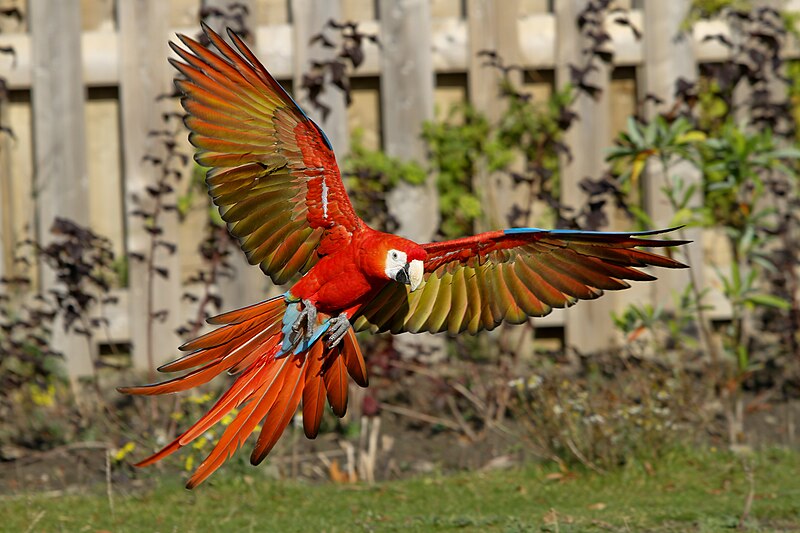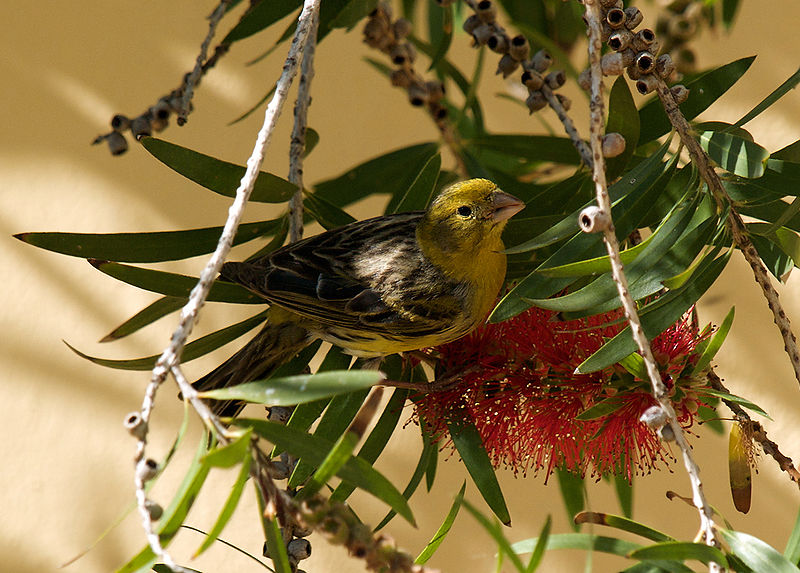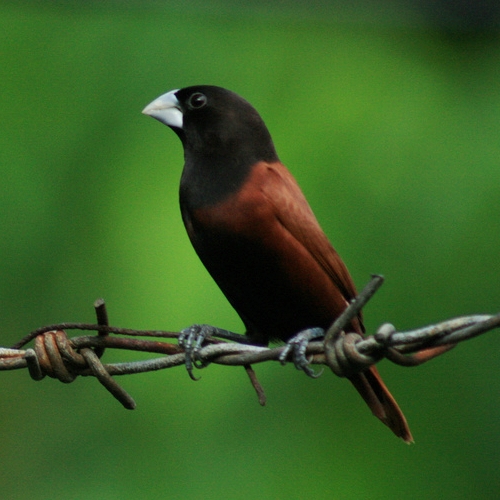 Sometimes viewed as less talkative “versions” of the popular Amazons, the Red-Vented Parrots (Pionus spp.) have until recently been overlooked by aviculturists. Many are now coming to realize that this is a mistake, as these wonderful birds have much to recommend them – at a fraction of the price of “flashier” species! Read More »
Sometimes viewed as less talkative “versions” of the popular Amazons, the Red-Vented Parrots (Pionus spp.) have until recently been overlooked by aviculturists. Many are now coming to realize that this is a mistake, as these wonderful birds have much to recommend them – at a fraction of the price of “flashier” species! Read More »
Category Archives: Bird Species Profiles
Feed SubscriptionMeet the Java Sparrow – Something Different for Finch Enthusiasts
 I’ve always viewed the Java Sparrow, Padda oryzivora, (a/k/a Java Rice Bird, Java Finch) as something of a “stepping stone” between the small, typical finches and the larger, less common softbills. Indeed, the moniker “sparrow” fits it well – despite being a true finch, its relatively large size (5 ½ inches), stout build and thick bill lend it a distinctly “un-finch-like” appearance. Read More »
I’ve always viewed the Java Sparrow, Padda oryzivora, (a/k/a Java Rice Bird, Java Finch) as something of a “stepping stone” between the small, typical finches and the larger, less common softbills. Indeed, the moniker “sparrow” fits it well – despite being a true finch, its relatively large size (5 ½ inches), stout build and thick bill lend it a distinctly “un-finch-like” appearance. Read More »
The Scarlet Macaw – The Wild Side of a Popular Pet
 The Scarlet Macaw (Ara macao) is surely one of the most recognizable birds on the planet. Images of this spectacular parrot adorn the brochures and T-shirts of travel agencies, zoos and aviaries worldwide. Less well-known, however, is its natural habits and precarious existence in the wild.
The Scarlet Macaw (Ara macao) is surely one of the most recognizable birds on the planet. Images of this spectacular parrot adorn the brochures and T-shirts of travel agencies, zoos and aviaries worldwide. Less well-known, however, is its natural habits and precarious existence in the wild.
Range
At 33.5 inches in length, and with a wingspan to match, this deep red (or scarlet!), yellow-shouldered bird is one of the world’s largest parrots.
Its huge range extends from Oaxaca in southern Mexico through Central America to Columbia, Peru, Bolivia and Brazil, and east to French Guiana. Within this area, however, it is rare or absent from many locales, and may be extinct in El Salvador. Feral populations thrive in Puerto Rico and Florida.
Read More »
Canary Types – an Amazing Array of Color, Size, Shape, Plumage and Song
For a somberly-colored bird, the Canary (Serinus canaria) has made quite an impression on us. Shipwrecks, vicious dogs and thievery all figured into the captive history (please see article below) of what is now the most popularly kept finch. Selective breeding has also resulted in an array of different types, some of which are barely recognizable as Canaries.
The First “Type” Canaries
 Different Canary varieties (termed “types”) first developed quite by accident. Canaries arrived in Europe in 1478, when they were taken to Spain from their native habitat on several islands off Northwest Africa. As the Spanish sold only males and travel was difficult, Canary owners usually bred related birds to one another. This increased the likelihood of mutations, including the yellow coloring that is now considered to be the Canary’s “normal” color (wild Canaries are actually greenish-brown). Read More »
Different Canary varieties (termed “types”) first developed quite by accident. Canaries arrived in Europe in 1478, when they were taken to Spain from their native habitat on several islands off Northwest Africa. As the Spanish sold only males and travel was difficult, Canary owners usually bred related birds to one another. This increased the likelihood of mutations, including the yellow coloring that is now considered to be the Canary’s “normal” color (wild Canaries are actually greenish-brown). Read More »
Hand Rearing Black-Headed Mannikins and Other Finches

While working for a bird importer in years past, I had the opportunity to hand-raise a number of finch chicks. The following information is based on recent and past experiences with the Black-Headed Mannikin (Lonchura atricapilla), also known as the Black-Headed Nun or Munia, but could be applied to a number of related birds.
The youngest chicks I’ve worked with were 4-6 days old and, like most Mannikins, had hatched in a domed nest (please see photo). They were reared in plastic containers lined with dry grass in an incubator set at 90 F (range: 86-93 F).
Feeding Nestlings
I feed very young finches at 2 hour intervals, from 5 or 6 AM to midnight at first, and cut back over 2 weeks or so to 6 AM – 8 PM. Hand Rearing Formula (warmed per directions) offered via syringe serves well as a base diet. Although not strictly necessary, to this I add a “drop” of peanut butter and 2 drops per syringe of sunflower oil. A bit of cooked egg yolk and a drop of Avitron, provided three times weekly, completes the feeding regime.
Despite their delicate appearance, healthy Mannikin chicks are ravenous. After a few days, they develop the amusing habit of raising one wing in order to ward off competitors…mini “jousting matches” sometimes break out!
Young Mannikins can only take a small amount at each feeding, and will choke or aspirate food into the lungs if it is forcibly squirted down their throats. The safest way to feed them is to gently release from the syringe just enough food to fill their mouths…at a frequency of every 2 hours, this will provide quite enough nourishment.
Care of Fledglings
 Upon fledging, the chicks should be fed on a 6AM – 8PM schedule until they begin pecking at food on their own. Most begin trying solid food on the fifth day after fledging, but this varies widely…close observation is very important at this point.
Upon fledging, the chicks should be fed on a 6AM – 8PM schedule until they begin pecking at food on their own. Most begin trying solid food on the fifth day after fledging, but this varies widely…close observation is very important at this point.
Their first meals should be offered on the cage floor, not in cups, to assure that they are aware of its presence. Seed-based Finch Nestling Food, Egg Food and cut sprouts should be available at all times.
Once the fledglings have begun to feed regularly on their own, you can gradually reduce the syringe feedings to 2-3 times per day. Continue this schedule until they lose interest in the syringe, which may take an additional 2-3 weeks. It is a mistake to rush the weaning process – birds decline in condition very rapidly at this age, and poor nutrition during the fledgling period will have lifelong consequences for their health.
Black-Headed Mannikins and related birds prefer to sleep in a nest or enclosed space, even outside of the breeding season. Fledglings raised together usually crowd into one covered nest, but provide extras in case of aggression.
Although generally quite hardy as adults, Mannikins are cold-sensitive as chicks. Until you are certain that their immune systems are functioning well, take extra care to keep the youngsters warm at night (a hot spot of 86-90 F, with an ambient temperature of 80-82 F, works well). A red or black night bulb, designed for use with reptiles, will provide heat without disturbing their day/night cycle.
Further Reading
Please see my article Introducing Mannikins for more information on these beautiful finches.
A video of Black-Headed Mannikins in the wild is posted here.
Black headed Finch image referenced from wikipedia and originally posted by SnowmanradioFinch nest image referenced from wikipedia and originally posted by Kguirnela
 That Bird Blog – Bird Care and History for Pet Birds
That Bird Blog – Bird Care and History for Pet Birds
